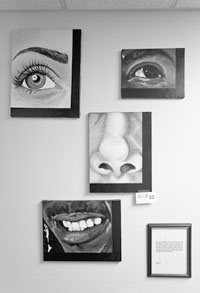| ||||||
The art of rehabilitation
by Jules Masterjohn The creative process can be a useful tool for bringing awareness to hidden aspects of ourselves. Art making, approached with purpose, is a safe haven for discovering and expressing difficult emotions. Through using specific colors, shapes, patterns and imagery, the “inner artist” gives visual form to feelings and experiences that may have had no means of expression, not even in words. Seeing what finds its way onto the canvas or into the clay can be an enlightening experience for the maker.
Recognizing the power of creativity for revealing inner truths, the Useful Public Service (UPS) department of the Sixth Judicial District established the DRAW program four years ago. DRAW – “Durango Restorative Art Work” – is an innovative program that offers offenders an opportunity to fulfill 24 hours of court-mandated public service through creating a work of art. “There is a lot of artistic talent in our community,” remarked Casey Bernhard, director of DRAW and UPS. More than 40 paintings, drawings and mixed-media works have been produced as restitution for offenses involving mainly alcohol and drugs. Twenty-five artworks are currently on display in the second floor hallways of the La Plata County Courthouse. Those whose artwork hangs in the courthouse initially presented art samples to a review committee to gain acceptance in the DRAW program. The participants were given six months to create their pieces, which upon completion became the property of the Sixth Judicial District, for purposes of display and possible sale. Accompanying each artwork is a required statement that reveals the artwork’s meaning and relevance to the DRAW participant. The descriptions are touching tales of the path from capture to freedom. Substance abuse is the most prevalent theme throughout the 25 pieces of work. Wine glasses and bottles of booze, along with images of balls ands chains and other symbols of enslavement, make their appearance on numerous canvases. Occasionally present are images of redemption, like the sun peeking through dark clouds or a cool, blue waterfall with its metaphor for cleansing. “Viewing this art is a powerful experience,” commented Vic Blasi, chief probation officer of the Sixth Judicial District. “Some of it is haunting and some is uplifting. Each work is as individual as the person who created it, often a reflection of their inner turmoil and struggle to overcome issues stemming from their abuse and restoring themselves to a balance within their community.” Bernhard and Blasi, with the assistance of Sharon Lemon, are getting the word out about the DRAW program through the current display and silent auction of artwork. Lemon, who works in marketing, said she volunteered her expertise because she was tremendously moved by the program’s concept of restoration of the individual vs. punishment. “I found that as I read the accompanying essays I was really impressed by many of the journeys the artists undertook in their legal process, related personal issues and healing,” she said. The DRAW project is unique and originated in La Plata County. Blasi explained, “Some years back, a probationer was required to do community service and in a conversation with his probation officer, he offered to create a piece of art for the front office. The idea grew from there.” Bernhard sees, first-hand, the program’s merit. “All participants I have dealt with have expressed how incredibly beneficial DRAW has been to them, as they cope with their charge. To see the change from when they come to the Useful Public Service office to sign up and when they submit their piece of art is truly remarkable and enjoyable. The pride they feel can be felt just by talking with them and accepting the final piece for the program.” The plan for DRAW is to auction the best of the art annually. The first silent auction, currently under way, will culminate March 21, raising funds to further develop the program. Bernhard encourages art lovers to come in early and place their bids. Bidders must print their name and phone number on a card and drop it into the bidder registration box located outside the Useful Public Service office on the first floor of the Courthouse. One former DRAW participant recently shared this observation. “I saw something recently that really bothered me: It was an ad that said ‘doing something for your community because you want to: positive karma; doing something for your community to fulfill community service: negative karma.’ That really bothered me. I did something I regret, but I am still helping my community through service. My eyes are opened to myself and to my community as a result. That might not have happened otherwise, and I am a better person for this experience.” •
|
In this week's issue...
- May 15, 2025
- End of the trail
Despite tariff pause, Colorado bike company can’t hang on through supply chain chaos
- May 8, 2025
- Shared pain
Dismal trend highlights need to cut usage in Upper Basin, too
- April 24, 2025
- A tale of two bills
Nuclear gets all the hype, but optimizing infrastructure will have bigger impact




